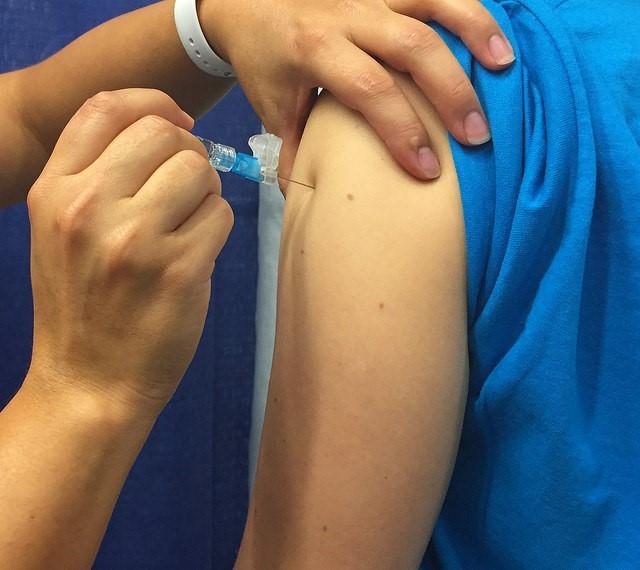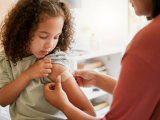Prior vaccination with seasonal influenza vaccine does not reduce the subsequent season's vaccine effectiveness (VE) in children ages 2 to 17 years. That's the takeaway from a study published today in JAMA Network Open.
"The results from the study give us reassurance that the vaccine is still a good thing to do each year," said Huong Q. McLean, PhD, MPH, the lead author of the study and a research scientist at the Marshfield Clinic Research Institute in Marshfield, Wisc., in an interview.
The subject of flu VE being affected by the previous season's coverage has been in debate in recent years, with some studies showing that prior vaccination may reduce current-season flu VE. For example, a Canadian study published last year showed that if the flu strains used in two vaccines are the same or very similar, VE can be diminished in the second year.
Researchers have called this phenomenon the "antigenic distance hypothesis" (ADH) to describe the possibility that the effectiveness of the current season's vaccine is hindered when the difference, or antigenic distance, between the two vaccines is small but the difference between the vaccine strains and the current epidemic strain is large.
Many ADH studies came out of the 2014-15 flu season, when H3N2 was the dominant subtype and flu vaccines performed poorly in both Canada and the United States. The H3N2 component in the vaccine that year was the same as in the 2013-14 flu vaccine, but it didn’t match with a new H3N2 "drifted" variant circulating in the population.
Focus on flu shot and LAIV
"Most studies have been in adults and have never really looked at children specifically, and just looking at inactivated vaccines," said McLean. "Our study looked at both the inactivated flu vaccine [IIV, or flu shot], and the live-attenuated inactivated vaccine [LAIV, or the nasal spray FluMist vaccine]."
The current study took place over three flu seasons (2013-14, 2014- 15, and 2015-16) at four US sites and enrolled 3,369 children, of whom 772 (23%) had a positive test result for influenza and 1,674 (50%) were vaccinated in the enrollment season.
Among LAIV recipients, VE against H3N2 was much higher among children vaccinated in both the enrollment and one prior season (50.3%; 95% confidence interval [CI], 17.0% to 70.2%) than among those without one prior season vaccination (−82.4%; 95% CI, −267.5% to 9.5%). VE of LAIV against influenza the H1N1 strain was likewise higher among those with prior season vaccination (47.5%; 95% CI, 11.4% to 68.9%) than those without (7.8%; 95% CI, −101.9% to 57.9%]).
Among children who received IIV, however, the results were similar whether the child had been vaccinated the previous year or not: 38.7% and 23.2% VE, respectively, for H3N2 and 72.4% and 67.5% for H1N1.
"What was so interesting to us was that the association carried with vaccine type used," said McLean. "The LAIV vaccine was more effective against H3N2 if a child had been vaccinated in a prior season, but the protection between seasons for H3N2 was the same as with the flu shot."
Contrary to other studies, the protection offered by prior LAIV vaccination was most prominent in the 2014-15 flu season. McLean said that same effect was not seen with H1N1.
"The antigenic distance hypothesis predicts negative interference from repeated vaccination when vaccine strains are identical [vaccine strain 1 is the same as vaccine strain 2] and circulating viruses are drifted, as occurred in the 2014-2015 season. However, the antigenic distance hypothesis was based on simulations of serologic response to inactivated vaccines, and differences in the adaptive immune response to LAIV and IIV might lead to different repeated vaccination effects in children," the study concluded.
In a commentary on the study, Sarah Cobey, PhD of the University of Chicago, said the results of the study "suggest additional support for the current Advisory Committee on Immunization Practices' recommendation that children be vaccinated annually against influenza. Although annual vaccinations may do little to enhance protection against influenza B, regular vaccinations might improve performance of the influenza A(H3N2) and influenza A(H1N1)pdm09 components."
See also:
Oct 26 JAMA Network Open study
Oct 26 JAMA Network Open commentary
Feb 10, 2017, CIDRAP News story "Studies shed light on effects of serial flu shots, current vaccine’s benefit"




















